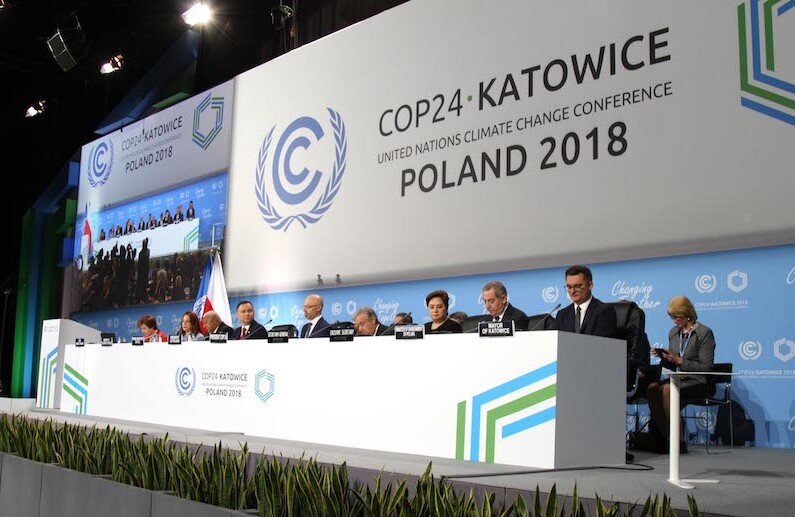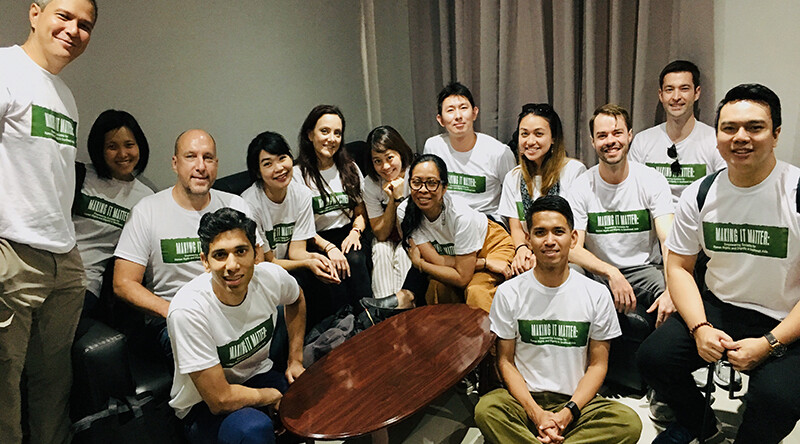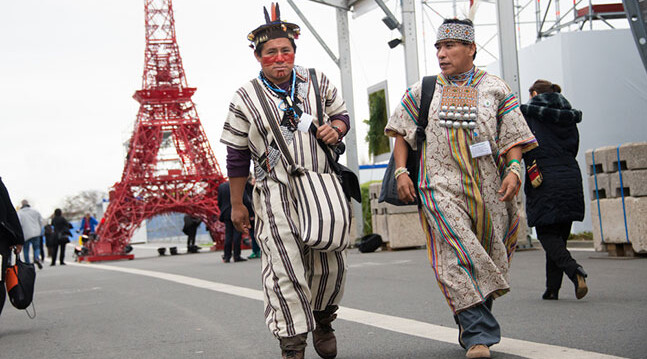This article also appears on the Ethics & International Affairs website.
While most media reports about COP24 in Katowice did recognize the "thousand little steps forward together" that would "keep the Paris agreement alive," the overall picture was one of barely contained conflict. Reporters stressed that the talks "limped" into an extra day (which was unsurprising, as even relatively inconsequential COPs run late). The New York Times called the public disagreement over whether the COP should "welcome" or "note" the recent IPCC report a "huge fight over climate science." One op-ed even claimed that the welcome/note debate "derailed this year's climate talks" completely. The Guardian extrapolated from that incident, among others, to conclude that whoever hosts COP26 in 2020 "will have a diplomatic mountain to climb."
Sources that specialize in the UNFCCC process, where the most important negotiations are informal and closed to observers, told a more optimistic story. While the talks were tense, difficult and tiring, as international negotiations are, the final texts that emerged were stronger and more comprehensive than most had predicted. Former French diplomat and Paris Agreement architect Laurence Tubiana referred to the outcome of Katowice as "really striking," while key NGO player Center for Climate and Energy Solutions called it "a major milestone" and the neutral observer Earth Negotiations Bulletin stated that it "delivered on its mandate." And despite the United States' role in the "absurd spat" over the IPCC report, the country played a neutral or even supportive role in the negotiations. While the White House's Wells Griffith was involved in a shameless plug for fossil fuels on the sidelines, the U.S. negotiating team was primarily composed of (and led by) experienced career officials, not political appointees. Together with China, who was a surprising ally for the EU, the U.S. helped forge crucial transparency rules on how the UNFCCC system will require countries to report progress toward their mitigation pledges and how these reports can be verified. Crucially, countries reached agreement on universal rules rather than relying on the old bifurcated system that had separate sets of rules for developed and developing countries.
It's not surprising that the media failed to really grasp the successes of Katowice: much more than in Paris, the highlights were in the wonky details. Apart from the universal transparency framework, one such detail was progress on the specific information required in countries' five-yearly mitigation pledges ("Nationally Determined Contributions" or "NDCs") (FCCC/CP/2018/L.22). Another was the new ability of the Implementation and Compliance Committee to effectively draw attention to a country if they have failed to provide any of a number of reports required by the Paris Agreement (FCCC/CP/2018/L.5 Annex III, para 22). Only one item on the agenda (the role of tradable carbon credits) was left undecided.1
Global agreements on "frameworks" and "modalities" are great, but will they keep global temperature increase "well below 2 degrees" or under 1.5 degrees Celsius of warming?2 As Alden Meyer of the Union of Concerned Scientists put it, "The real test is what happens when countries go home. All the decision text in the world doesn't cut a molecule of carbon. You need action on the ground." A Financial Times editorial struck an even more cautious note on this subject, rightly pointing out that the current mitigation pledges are "inadequate" to meet even the lesser of the Paris Agreement's collective goals, and that COP24 negotiations "have not changed this in any way."
Timing of Pledge
It is true that the Paris mitigation pledges are vastly inadequate, putting us on track to a dangerous world of 3 degrees warming or more by 2100. Does this mean that the Paris Agreement is just hot air? Developing countries can (and often do) rightly object to the lack of progress in the lame-duck pre-2020 regime. But the Paris system itself, which begins in earnest in 2020, is proceeding according to design. Countries were intended to digest the 2018 IPCC report on the 1.5 degree target, and the conclusion of the inclusive two-year Talanoa dialogue at Katowice, before formulating new mitigation pledges by early 2020.
The "ratchet mechanism" in the Paris Agreement (Article 4.3) means that each one of these pledges must "represent a progression beyond" the initial pledge that countries made in 2015 or soon after.
This early-2020 deadline should be on the mind of every climate-focused NGO, since countries should already be in the process of formulating their updates. The NDC update process represents a valuable opportunity for NGOs to influence global climate policy. There are of course many different ways that civil society can raise ambition, but I want to draw attention to three strategies in particular.
Pressing Domestically for an Ambitious Pledge
One strategy for raising ambition is to aim to generate the political will for much stronger mitigation pledges from every player domestically, which in turn will generate the mutual trust needed to solve the collective action problems of climate change. The directness with which NGOs and activists are able to foster political will in their home countries for powerful pledges will vary. When dealing with governments that are committed to public deliberation, civil society can certainly demand to know how their country's mitigation pledge will represent its "highest possible ambition" and "a progression" beyond its previous pledge while reflecting UNFCCC equity principles (Paris Agreement, 4.3). In countries with a weaker public deliberation tradition, that role may have to be more nuanced.
But civil society pressure need not be limited to adversarial or public-facing actions. NGOs can help build bridges between political actors. For instance, they can assist fledgling research and industry actors in clean tech and other mitigation areas to signal to policymakers what domestic climate targets might be feasible with the right support. They can also act as intermediaries between decision-makers and key constituencies who would be affected by concrete climate policies, to avoid triggering popular backlash such as that which occurred in France recently. All of these roles have the potential of raising the ceiling of what "highest possible ambition" might mean for a given country.
What would this strategy mean for civil society in the United States, a country whose head of state has signaled intent to withdraw from Paris and is unlikely to submit a new mitigation pledge by 2020? First of all, the global community would likely consider a U.S. mitigation pledge in 2021 as better late than never. Thus civil society can pressure 2020 presidential candidates to develop a "shadow pledge" to prepare for a post-Trump federal policy and send positive signals to domestic industry and a range of external actors. Furthermore, the #wearestillin movement can work to present a "virtual pledge" made up of a credible aggregate of mitigation goals made by subnational actors like cities and states in light of the federal neglect of climate policy.
Comparing mitigation pledges
A second strategy for civil society is to harness reputational effects at the international level through mitigation pledge comparisons. Here we need to shift our analysis from the lower level game of domestic politics to the higher-level game of countries' global interactions. As Jennifer Jacquet and Dale Jamieson put it in a Nature Climate Change paper: "For pledge and review to succeed, the basic challenge remains: the cost of failing to make and fulfil ambitious pledges must exceed the benefits of business as usual. The soft power of reputation is an important factor in this calculation."
Before Katowice, many NGOs held out hope that the UNFCCC's new five-yearly "Global Stocktake" might be a major forum for climate leaders to bring this soft power to bear against climate laggards. However, Katowice has made it very clear that the Stocktake cannot single out any players for special attention, stating that it "should … have no individual Party focus" (FCCC/CP/2018/L.16 Section I.14). Consequently, civil society must continue to make its own decisions about how to best generate and channel the reputational effects that the Paris Agreement relies upon. Evidently, comparisons of the mitigation pledges of various countries are needed for civil society to play the role of "informal monitor" (as Robert Falkner describes it) to the Paris Agreement.
But such comparisons will be less effective if done in an ad hoc or obviously partisan way. As I have argued before, in order to effectively "name and shame" climate laggards and "raise and praise" climate leaders, civil society information must demonstrate credibility, be simple to grasp, and be adequately granular.
Climate pledge comparisons have been on the scene for several years now, and some progress has been made. Climate Action Tracker's work remains idiosyncratic and academia-focused in its methodology, but has increased its granularity, now separating countries into five, rather than four, categories of ambition. Civil Society Review repackaged its assessment for the 2018 Talanoa dialogue, and then again in a report called "After Paris." It continues to use quite progressive assumptions about the distinction between subsistence and luxury emissions, which lead to the conclusion that it is developed countries, including the EU, and not the rapidly growing economies, that continue to let the global team down
A relatively new player on the scene, The Paris Equity Check is admirable in scope, as it includes every country in the Paris Agreement, whereas Climate Action Tracker and Civil Society Review are more selective. In its more useful and granular "pledged warming map" the Check aims for credibility by leaving the decision about which of three fairness metrics (historical responsibility, capacity, or equal per-capita emissions) to whichever most favors each country. Then, through some complicated modelling, it projects what level of warming would occur if every country put forward the same level of ambition (according to their preferred metric of the three).
Despite the relative humility about being able to explicitly define fairness, Paris Equity Check has nevertheless garnered major controversy.3 Buried in the details of how capacity and equal per-capita emissions are measured is an admission that, under two of the three fairness metrics, Paris Equity Check allows a thirty-year period of grandfathering. Thus, a more polluting country is (perversely) given more lenient targets in the near term, and less polluting countries have to take up the slack. Further, the idea of historical responsibility for emissions before 1990 is ruled out as an input into any fairness metric. These choices have left the Equity Check open to strong criticism, not only from the architects of the Civil Society Review, but from some of the foremost names in academic climate ethics.
For an effective and fair review by civil society, I still recommend building equity into an economic comparability of effort approach, and hold that organizing countries into many development clusters and then ranking countries within groups would be a welcome addition.
However, given the time constraints, for this round of pledge updates, reputational effects must proceed via existing reviews: the Civil Society Review, the Climate Action Tracker, and the Paris Equity Check.4 It is up to the architects of such reviews to revise them to increase their credibility, clarity, and granularity (as well as the amount of countries assessed), and up to the rest of civil society to publicize and support them. For instance, civil society can push countries to include specific reference to each of the three reviews' verdict about their previous pledge, to put their new pledge into appropriate context. Further, a civil society group could create a review aggregator that can show the public at a glance how well each country is in terms of all current reviews (as well as explaining briefly the methodology of each review). In these ways, the review process by civil society can become a credible litmus test of global climate ambition, in the same way other indexes such as the Corruption Perception Index play on other issues. The incentives created by doing better on such a test can entice many countries to submit much more ambitious mitigation pledges in 2020 and beyond.
Facilitating the "Means of Implementation"
Besides domestic and international action to try to increase mitigation pledges directly, there is yet another strategy civil society can use to increase mitigation ambition. This is facilitating international cooperation on what is known in the UNFCCC as the "means of implementation": financial support, technology transfer (including intellectual property), and capacity building.
Aside from a few hopeful announcements, Katowice was quite disappointing regarding climate finance. For instance, fewer pledges of climate grants from developed countries emerged than usual. Aside from the robust ethical argument that developed countries owe developing countries support for climate action, such support can also be found in the enlightened self-interest of developed countries. This is because increased finance flows and other means of implementation will often trigger more ambitious developing country mitigation pledges that are "conditional" on receiving appropriate support.
Again, civil society, specifically in wealthy countries, has a role to play internally in creating political will from within for mobilizing the various means of implementation. And as with mitigation pledges, there is also a role for civil society to provide credible, balanced international assessments of who is doing more in the field of means of implementation, a topic that is almost as controversial and difficult to measure as emissions pledges.
UN Secretary-General Antonio Guterres stated at the closing of the COP that he has five priorities looking ahead: "ambition, ambition, ambition, ambition, and ambition." He went on to explain that he was referring to five types of ambition: ambition in mitigation, adaptation, finance, technical cooperation and capacity-building, and technological innovation. To these ends, Guterres will convene a high-level summit in September 2019. But the work to raise ambition within our own countries, and to improve the measurement of ambition from all countries, is required from us, now. Let's be smart about it.
NOTES
1 For further accessible yet detailed analysis of the text that Katowice delivered, see the excellent work by C2ES or IISD's Earth Negotiations Bulletin.
2 These are the twin collective mitigation goals from the Paris Agreement (Article 2.1)
3 Of course, as a matter of practicality, countries with higher emissions will need longer to reduce their emissions to their fair share, but that (arguably) should play no role in assessing the fairness of their ambition. As the Civil Society Review points out, countries can make up for shortfalls between their fair share and any feasible reduction by providing means of implementation for other countries (see below).
4 Countries' pledges will also feed into more general indexes of climate change ambition, being 10 percent of the score in Climate Action Network's Climate Performance Index.



